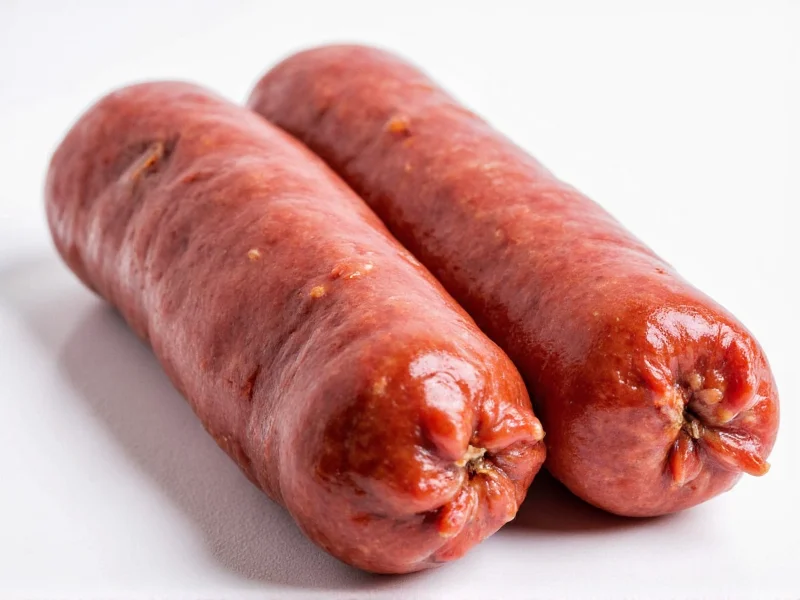Freezing summer sausage properly extends its shelf life while maintaining quality. This guide provides science-based recommendations for freezing, storing, and thawing summer sausage to ensure optimal results every time.
Understanding Summer Sausage Freezing Basics
Summer sausage, a semi-dry cured meat product, responds well to freezing when handled correctly. Unlike fresh sausages, its lower moisture content and curing process make it more freezer-stable. The curing process already removes significant moisture, which helps prevent ice crystal formation that damages texture.
When considering how to freeze summer sausage properly, remember that proper packaging is more critical than the freezing process itself. Air exposure causes freezer burn, which degrades both texture and flavor. Vacuum sealing provides the best protection, but proper wrapping techniques work well for home freezers.
Step-by-Step Freezing Instructions
Follow these steps for optimal summer sausage freezer storage:
- Check expiration date - Freeze sausage before its "use by" date for best results
- Keep original packaging intact if unopened, then add additional protection
- For opened packages, wrap tightly in heavy-duty aluminum foil or freezer paper
- Vacuum sealing provides superior protection against freezer burn
- Label packages with contents and freezing date
- Store at 0°F (-18°C) or below in the coldest part of your freezer
Storage Duration Guidelines
While frozen foods remain safe indefinitely at proper temperatures, quality degrades over time. The following table shows optimal storage times for how long can you freeze summer sausage:
| Storage Method | Optimal Quality Duration | Maximum Safety Duration |
|---|---|---|
| Vacuum sealed | 2 months | 3 months |
| Heavy-duty freezer wrap | 1-2 months | 2 months |
| Original packaging (unopened) | 1 month | 1.5 months |
| Plastic wrap or regular foil | 2-3 weeks | 1 month |
Thawing Frozen Summer Sausage Safely
Proper thawing preserves texture and prevents bacterial growth. The best way to store summer sausage after freezing involves careful thawing:
- Refrigerator thawing (recommended): Place sealed package in refrigerator for 24-48 hours
- Cold water method: Submerge sealed package in cold water, changing water every 30 minutes (2-3 hours)
- Never thaw at room temperature - this promotes bacterial growth in the danger zone (40°F-140°F)
- Do not use microwave for thawing - uneven heating damages texture
Once thawed, consume within 3-5 days. Do not refreeze previously frozen summer sausage unless it was thawed in the refrigerator and hasn't exceeded recommended storage times.
Quality Considerations After Freezing
While freezing preserves safety, some quality changes may occur. Understanding does freezing affect summer sausage quality helps set proper expectations:
- Texture: May become slightly drier but should remain sliceable
- Flavor: Generally well-preserved with proper packaging
- Color: May darken slightly but remains safe to eat
- Moisture: Some separation may occur but redistributes when brought to room temperature
Freezer burn appears as grayish-brown leathery spots and affects quality but not safety. Trim affected areas before serving. The summer sausage freezer storage tips that prevent freezer burn include removing all air from packaging and maintaining consistent freezer temperature.
Common Freezing Mistakes to Avoid
Avoid these pitfalls when preserving summer sausage by freezing:
- Using regular plastic bags instead of freezer-safe materials
- Leaving sausage in original store packaging without additional protection
- Freezing at temperatures above 0°F (-18°C)
- Storing for longer than recommended quality periods
- Thawing at room temperature
- Refreezing after improper thawing
Safety Considerations
Food safety remains paramount when thawing frozen summer sausage safely. While freezing stops bacterial growth, it doesn't kill existing bacteria. Always follow these safety guidelines:
- Keep freezer at or below 0°F (-18°C)
- Thaw only in refrigerator or cold water
- Consume within recommended timeframes after thawing
- Discard if unpleasant odors develop after thawing
- When in doubt, throw it out - don't risk foodborne illness
Practical Applications
Freezing summer sausage works well for:
- Preserving bulk purchases during sales
- Storing homemade summer sausage
- Preparing for emergencies or long-term storage
- Managing inventory for small food businesses
- Preserving specialty varieties for future enjoyment
By following these guidelines for can you refreeze summer sausage considerations and proper storage techniques, you'll maintain quality while extending shelf life. The key is consistent temperature control and proper packaging throughout the freezing process.











 浙公网安备
33010002000092号
浙公网安备
33010002000092号 浙B2-20120091-4
浙B2-20120091-4